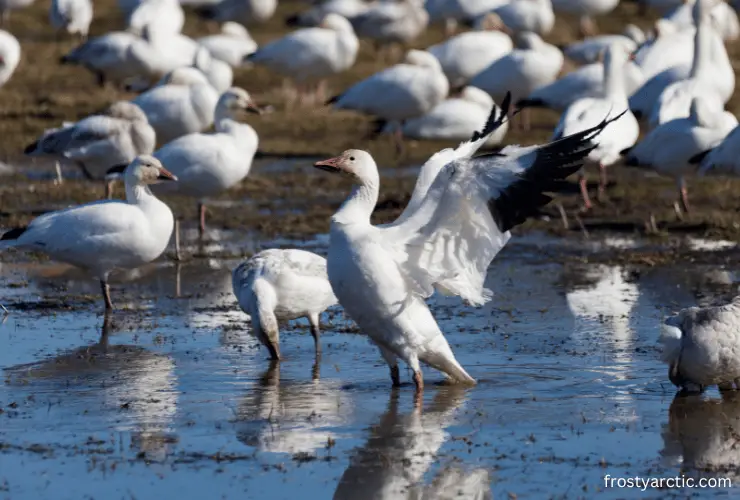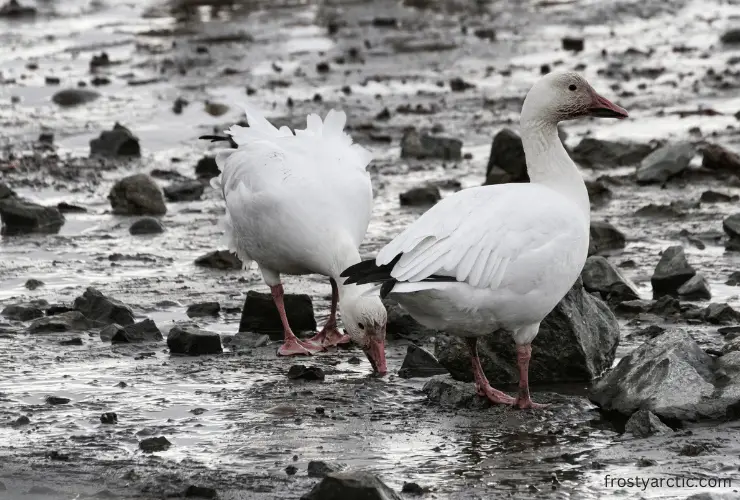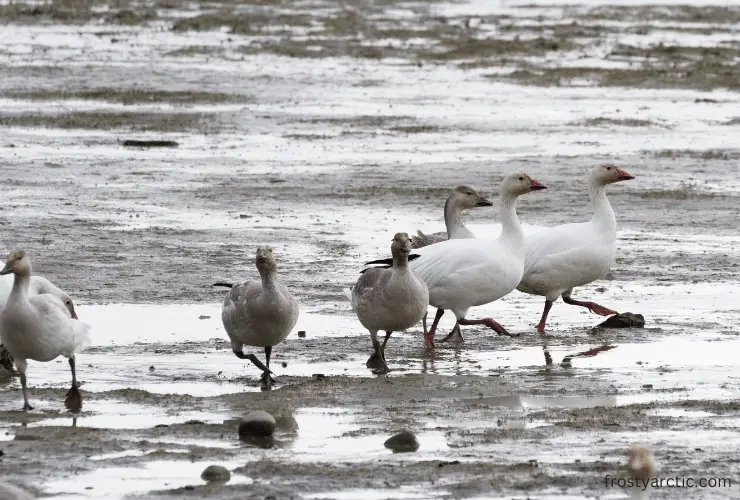Yes, the species of snow goose can be found in Canada. Snow geese mainly inhabit the Arctic and subarctic regions of Canada. Basically, they breed and nest there. Moreover, Canada is home to many different species of birds, including the magnificent Snow Goose.
The migratory habits and breeding characteristics of snow geese are particularly fascinating. The regulation of the populations of snow geese is also being made in several ways. These beautiful birds are well known for their striking white feathers and graceful flight patterns. Their large flocks can be quite a sight to see!
So, do you have any questions about Snow Geese in Canada? Where is your favorite place to spot them? We’ve got all the details on where to find them, their migration patterns, and much more. You can learn more interesting facts about these iconic species of snow geese here. So, let’s delve further into the article given below!
Are there Snow Geese in Canada? Types of Snow Geese in Canada

As we have mentioned before, there are snow geese in Canada. Snow geese are a common species of waterfowl found throughout North America, including Canada. They often stop in the Canadian prairies to rest and feed during their migration southward during winter. They breed in the Arctic and subarctic regions of Canada in the summer. Let’s discuss its types below:
Types of Snow Geese found in Canada
According to the Canadian Wild life Federation, snow geese have a few types. These are:
Lesser Snow Goose
The Lesser Snow Goose is a smaller species of snow goose that breeds in the Arctic and subarctic regions of North America. They have distinctive white bodies, black wingtips, and pink bills and feet. Most Lesser Snow Geese migrate to the western United States and Mexico for the winter.
However, a small “Wrangel Island” population migrates to the eastern coast of Canada. The Lesser Snow Goose possesses a wingspan that typically measures around 90 cm. It has an average weight that falls within the range of 2.2 to 2.7 kg. Generally, males of this species tend to be larger than females.
Greater Snow Goose
The Greater Snow Goose is a larger species of Snow Goose with a similar appearance to the Lesser Snow Goose. They breed in the eastern Arctic and subarctic regions of Canada.
They usually migrate southward to the eastern United States for the winter. The Greater Snow Goose population has increased significantly in recent decades. It leads to concerns about the overgrazing of habitats. More interestingly, the females of greater snow geese usually lay up to 4 eggs.
Ross’s Goose
Ross’s Goose is a smaller species of snow goose. It was named after American naturalist Bernard R. Ross. These snow geese resemble the Lesser Snow Goose but have a smaller bill and a rounder head. After breeding in the Arctic regions of Canada, they move southward to the central United States to seek shelter in winter.
Ross’s Goose has a relatively small population and is considered a species of special concern in Canada. In other words, Blue-phase Ross’s Geese are not commonly found. Ross’s Geese have a high-pitched, nasal “kyi kyi” call often described as sounding like a dog toy squeaker.
How many Snow Geese are there in Canada?
The population estimates for different goose species in Canada are listed below in a table from a report created by the Canadian Wildlife Service’s Waterfowl Technical Committee: ~(Source)
| Species Of Goose | Regions | 2019 Breeding Population Estimate | |
| 1 | Lesser Snow Goose | Mid-Continent | 7.23 Million Adults |
| 2 | Lesser Snow Goose | Western Arctic | 1.09 Million Adults |
| 3 | Lesser Snow Goose | Wrangel Island | 442 Thousand Adults |
Where do Snow Geese Live in Canada?

According to Duck’s organization, snow geese can be found in Canada in the following regions: ~ source
- Foxe Basin is located in Nunavut, Canada
- The northern Baffin, Bylot, Axel Heiberg, and the Ellesmere Islands (all of these areas are located in Nunavut, Canada)
Moreover, snow geese can also be found in the following regions of Canada:
- Hudson Bay Lowlands, Ontario
- James Bay, Quebec
- Churchill, Manitoba
- Delta Marsh, Manitoba
- Prince Edward Island National Park, Prince Edward Island
- St. Lawrence River Estuary, Quebec
- Gulf of St. Lawrence, Quebec
- Riding Mountain National Park, Manitoba
Overall, snow geese can be seen from the Arctic islands to the southern shores of Hudson Bay and the St. Lawrence River Estuary. According to CityNews, thousands of snow geese landed in Richmond, B.C. Park. This is a mesmerizing moment for beauty lovers. ~ source
a) Snow Geese in Canada (North-Ontario)
Yes, snow geese can be found in the sub-Arctic regions of northern Ontario during their breeding seasons. The days become shorter and less frigid in these regions during spring and summer, which is the breeding season of snow geese.
These summer breeding lands also provide snow geese with the ideal wetland habitats for their mating and nesting. One popular location to see snow geese in North Ontario is the Alfred Bog. It is located near the Ottawa River. This area is a critical stopover site for migrating birds like snow geese.
Other areas in northern Ontario that are known to attract snow geese during migration include the following:
- James Bay coast
- Lake Nipissing
- Manitoulin Island region
Overall, snow geese are an important part of the ecosystem in Canada. They provide a beautiful spectacle for birdwatchers and nature enthusiasts alike.
b) Snow Geese in South Ontario
After the breeding season, snow geese begin their migration toward the southern part of Canada. This journey starts when winter is just around the corner. Snow geese stop in southern Ontario during their migration route from northern Canada to southern Canada.
They stay in the south region of Ontario for some time to feed and rest. They travel through the Great Lakes region and can often be spotted in areas such as Point Pelee National Park, Rondeau Provincial Park, and the Long Point area.
How Can People Observe Snow Geese in Canada?

There are many opportunities for people to observe snow geese in Canada during their migration. Some popular locations include:
- Wildlife refuges: Several wildlife refuges in Canada offer opportunities to observe snow geese. These may include the Last Mountain Lake National Wildlife Area in Saskatchewan and the Delta Marsh Wildlife Management Area in Manitoba.
- Birdwatching tours: Some tour companies offer guided birdwatching tours. They specifically focus on observing snow geese and other waterfowl species in Canada.
- Coastal areas: Snow geese can often be seen along coastal areas during migration. These areas may include the Great Lakes’ shores or the Hudson Bay’s coast.
Moreover, snow geese can also be observed in National Parks and Provisional Parks in Canada. We have also shared other locations in the above section where snow geese can be found. Following appropriate wildlife viewing etiquette is important when observing snow geese and other wildlife. Do not disturb their natural behavior or habitat!
Frequently Asked Questions (FAQs)
Are snow geese protected in Canada?
Yes. In Canada, Snow Geese are a protected species under the Migratory Birds Convention Act. This legislation prohibits the hunting or harming of Snow Geese without proper permits. The permits are issued only for scientific, educational, or Aboriginal subsistence purposes.
Additionally, the hunting of snow geese is regulated through the Migratory Birds Regulations. This act set limits on the number of birds that can be harvested each year. It also restricts hunting methods to ensure sustainability. ~ source
Can you hunt snow geese in Canada?
Yes, snow geese can be legally hunted in Canada during the appropriate hunting season. They can be hunted by federal and provincial hunting regulations. However, it’s important to note that regulations may vary depending on the province, territory, and specific management area where you plan to hunt.
Additionally, hunters are required to follow the following:
- Obtain the appropriate licenses and permits
- Use non-toxic shots
- Adhere to any bag limits
- Follow possession limits
- Stick to other regulations that may apply
It’s important to consult the relevant hunting regulations for the specific area where you plan to hunt. It’s essential to hunt ethically and sustainably.
How many snow geese can you shoot in Canada?
The daily bag limit for White-fronted Geese has increased to 8 birds per day. Also, the possession limit has increased to 24. Additionally, the aggregate limit for Canada Geese, Cackling Geese, and White-fronted Geese combined is 8 in the daily bag and 24 in the possession limit.
It’s important to note that these regulations are specific to the province of Saskatchewan. The regulations in other provinces or territories may differ. Additionally, the number of snow geese that can be legally harvested may change yearly. It is based on population levels and other factors. ~ source
Conclusion
Snow geese are highly intriguing species of migratory birds. These birds are known to have the longest migratory journey among migratory species. They can modify themselves according to their environment. This has made their survival possible, not only in the far northern lands but also in urban areas. Snow geese also have useful impacts on their environment.



1 thought on “Are there Snow Geese in Canada?”